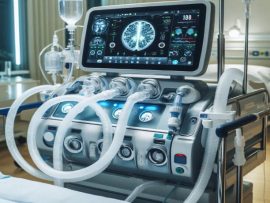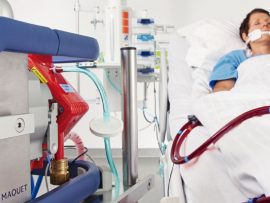Abstract Background To evaluate the association between intraoperative end-tidal carbon dioxide (ETCO₂) levels and clinical outcomes in patients undergoing cardiac surgery. Methods This retrospective analysis included patients who underwent cardiac..
Read MoreAbstract Background Cardiopulmonary bypass use during surgery disrupts microcirculation, which can contribute to lung injury, particularly in patients with pulmonary comorbidities. Continuous transcutaneous carbon dioxide (CO2) monitoring assists clinicians to..
Read MoreAbstract Background Cardiac surgery is associated with increased risk of major adverse outcomes. Venous to arterial carbon dioxide tension gap (Pv-aCO2 gap) showed significant prognostic value of non-cardiac surgery, while their..
Read MoreAbstract Background Cardiac surgery is associated with increased risk of major adverse outcomes. Venous to arterial carbon dioxide tension gap (Pv-aCO2 gap) showed significant prognostic value of non-cardiac surgery, while their..
Read MoreAbstract Objective To assess the effects of dexmedetomidine (DEX) on cerebrovascular autoregulation in children with congenital heart disease (CHD) using transcranial color-coded duplex sonography (TCCD). Design Randomized controlled trial. Setting..
Read MoreAbstract Extracorporeal carbon dioxide removal (ECCO2R) is an emerging technique designed to reduce carbon dioxide (CO2) levels in venous blood while enabling lung-protective ventilation or alleviating the work of breathing...
Read MoreAbstract Background: Management of arterial carbon dioxide tension (PaCO₂) during extracorporeal circulation is critical to maintaining physiological stability. Both cardiopulmonary bypass (CPB) and extracorporeal membrane oxygenation (ECMO) significantly alter natural..
Read MoreAbstract Recently, advancements in extracorporeal carbon dioxide removal (ECCO2R) technology have markedly enhanced its clinical applicability and efficacy for managing severe respiratory conditions. This review highlights critical innovations in ECCO2R,..
Read MoreAbstract As mortality relating to severe acute burn injury improves, patients are surviving longer into the critical care phase, which is commonly complicated by multisystem organ failure. Extracorporeal organ support..
Read MoreAbstract Extracorporeal Carbon Dioxide Removal (ECCO2R) systems support patients with severe respiratory failure. Concurrent ambulation and physical therapy improve patient outcomes, but these procedures are limited by the complexity and..
Read MoreAbstract The therapeutic target of extracorporeal carbon dioxide removal (ECCO2R) is the elimination of carbon dioxide (CO2) from the blood across a gas exchange membrane without influencing oxygenation to a clinically relevant..
Read MoreAbstract Purpose To assess the association between fluctuations of arterial carbon dioxide early after start of (ECMO) with (ICH) or (IS). Materials and methods This single-center retrospective study included patients who required ECMO..
Read MoreAbstract Target values for arterial carbon dioxide tension (PaCO2) in extracorporeal membrane oxygenation (ECMO) for acute respiratory distress syndrome (ARDS) are unknown. We hypothesized that lower PaCO2 values on ECMO would..
Read MoreAbstract Rationale: It is unclear whether extracorporeal CO2 removal (ECCO2R) can reduce the rate of intubation or the total time on invasive mechanical ventilation (IMV) in adults experiencing an exacerbation of chronic..
Read MoreAbstract Introduction Brain injury is common following open heart valve surgery. Carbon dioxide insufflation (CDI) has been proposed to reduce the incidence of brain injury by reducing the number of air..
Read MoreAbstract The aim of this experimantal study which is applied on rats, is to determine the differences on the clotting factors over the application of low and high intraabdominal pressure..
Read MoreAbstract Background Acute brain injury (ABI) remains common after extracorporeal cardiopulmonary resuscitation (ECPR). Using a large international multicenter cohort, we investigated the impact of peri-cannulation arterial oxygen (PaO2) and carbon..
Read MoreAbstract Background Insufflation of carbon dioxide (CO2) into the operative field to prevent cerebral or myocardial damage by air embolism is a well known strategy in open-heart surgery. However, here..
Read MoreAbstract OBJECTIVES Carbon dioxide (CO2) gas insufflation is used for continuous de-airing during open heart surgery. The aim was to evaluate if an additional separate venous reservoir eliminates CO2 insufflation-induced..
Read MoreAbstract Background A retrospective analysis of SUPERNOVA trial data showed that reductions in tidal volume to ultraprotective levels without significant increases in arterial partial pressure of carbon dioxide (PaCO2) for..
Read MoreAbstract Objectives To test the clinical performance of a novel continuous noninvasive cardiac output (CO) monitoring based on expired carbon dioxide kinetics in cardiac surgery patients. Design A prospective feasibility..
Read MoreAbstract Introduction: Evidence suggests the high capability of non-invasive assessment of the End-tidal carbondioxide (ETCO2) in predicting changes in arterial carbon dioxide pressure (PCO2) following major surgeries in children. We aimed..
Read MoreAbstract OBJECTIVES Carbon dioxide (CO2) gas insufflation is used for continuous de-airing during open heart surgery. The aim was to evaluate if an additional separate venous reservoir eliminates..
Read MoreAbstract Introduction: The use of cardiopulmonary bypass is associated with a risk of neurocognitive deficit caused by gaseous microemboli. Flushing the empty bypass circuit with carbon dioxide, which is more..
Read MoreAbstract Rationale: We developed an innovative, minimally invasive, highly efficient extracorporeal CO2 removal (ECCO2R) technique called respiratory electrodialysis (R-ED). Objectives: To evaluate the efficacy of R-ED in controlling ventilation compared with..
Read MoreAbstract Background: Previous work has demonstrated paradoxical increases in cerebral oxygen saturation (ScO2) as blood pressure decreases and paradoxical decreases in ScO2 as blood pressure increases. It has been suggested that..
Read More











